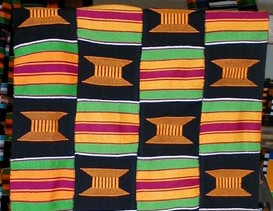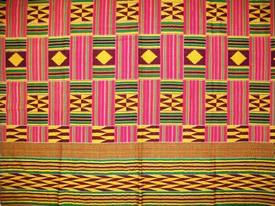|
|
 |
 |
 |
Kente Cloth
Kente clothing and
academic stoles are often used by African Americans ( Blacks) as a symbol of ethnic pride. This practice is also very popular with historcally Greek letter fraternities and sororities. Black students hold special ceremonies called "Donning of the Kente" where the stoles are presented to the graduates.
Kente, known as nwentom in Akan, is a type of silk and cotton fabrid made of interwoven cloth strips and is native to the Akan ethnic group os South Ghana. Kente is made in Akan lands such as Ashanti Kingdom, (Bonwire, Adanwomase, Sakora Wonoo, Ntonso in the Kwabre areas of the Ashanti Region) It is also worn by many other groups who have been influenced by Akans. Kente comes from the word kenten, which means basket in Akandialect Asante. Akans refer to kente as nwentoma, meaning woven cloth. It is an Akan royal and sacred cloth worn only in times of extreme importance and was the cloth of kings. Over time, the use of kente became more widespread. However, its importance has remained and it is held in high esteem with Akans. The Ewe people especially those from Agortime-Kpetoe of Ghana also claim that, Kente which they also refer to as Agbamevor has always been their traditional cloth. Per the oral history of the people, during the Ashante wars they captured some of their men who were skilled in the weaving of Agbamevor. These slaves were asked by their captors (Ashantes) to teach them how to weave Agbamevor; the Ewe kente experts instruct them to "Ke" meaning spread or open in the Ewe language, pass the waft through, and "Te" meaning tighten or press also in Ewe. For that reason, the Ewes believe that the name Kete originates from the method used to weave such cloths which is also the same name that has been corrupted into kente, as time goes on.
|
|
 |
 |
 |
West Africa has had a cloth weaving
culture for centuries via the strip weave method, but Akan history tells of the
cloth being created independent of outsider influence. Kente cloth has its
origin from the Ashanti kingdom in Ghana , and was later adopted by the
Ashanti’s in Ivory Coast who historically migrated from Ghana. The origin of
kente is in the Akan empire
of Bonoman. Most Akans migrated out of the area that was Bonoman to create
various states. The Ewe people think the weaving of Kente originates with them,
although they are not claiming they invented the art of weaving. They suggest
that the name is derived from Kete which relates to the two alternating rhythmic
actions (ke and te, meaning open and press in the Ewe language) associated with
the weaving of the loom.
The Maroon people of Suriname in South America are the descendants of people who were brought from Africa as slaves after the mid-17th century and who escaped to live in the forests of the interior, eventually obtaining the right of self-government from the colonial powers. The Pangi cloth made by the Maroons is a cotton fabric with multi-colored vertical and horizontal stripes, similar to West African kente cloth.
Meanings of the colors in kente
cloth
· black: maturation, intensified spiritual energy
· blue: peacefulness, harmony and love
· green: vegetation, planting, harvesting, growth, spiritual renewal
· gold: royalty, wealth, high status, glory, spiritual purity
· grey: healing and cleansing rituals; associated with ash
· maroon: the color of mother earth; associated with healing
· pink: assoc. with the female essence of life; a mild, gentle aspect of red
· purple: assoc. with feminine aspects of life; usually worn by women
· red: political and spiritual moods; bloodshed; sacrificial rites and death.
· silver: serenity, purity, joy; associated with the moon
· white: purification, sanctification rites and festive occasions
· yellow: preciousness, royalty, wealth, fertility, beauty
A variety of kente patterns have been invented, each of which has a certain concept or concepts traditionally associated with it. For example, the Obaakofoo Mmu Man pattern symbolizes democratic rule; Emaa Da, novel creativity and knowledge from experience; and Sika Fre Mogya, responsibility to share monetary success with one's relations.
Legend has it that kente was first made by two Akan friends who went hunting in an Asanteman forest found a spider making its web. The friends stood and watched the spider for two days then returned home and implemented what they had seen.
Thanks for Stopping By ourblackhistory.com
Click Here To
Leave Comment